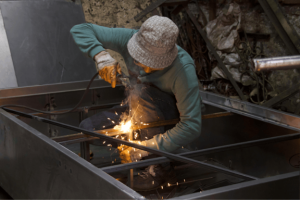Last Updated on October 30, 2025 by teamobn
Home improvement projects can be a rewarding way to improve your living space, but they often come with hidden challenges. Even if you’re excited to take on the task, DIY mistakes can turn your dream project into a costly headache. Understanding common pitfalls can help you avoid wasting time and money.
Here are some of the most frequent DIY mistakes homeowners make and how you can sidestep them.
9 Home DIY Mistakes That Can Cost You More in the End
When it comes to home improvement, many people take on DIY projects with the goal of saving money and increasing their home’s value. While this can be a rewarding and cost-effective way to improve your space, it’s easy to make mistakes that ultimately lead to more expenses. These missteps often happen when people are overly ambitious, rush through tasks, or fail to plan properly. Some mistakes are easy to overlook but can cost you in both time and money.
Ignoring Permits and Building Codes
One of the biggest DIY mistakes you can make is starting a project without checking local building codes or acquiring the necessary permits. While it might seem like an unnecessary step, skipping this can lead to hefty fines or the need to tear down your work if authorities find out.
For instance, if you’re adding an extension or building a deck, not adhering to these codes can also affect your home’s resale value.
Why this matters: Permits and building codes guarantee that your work is up to standard, making your home safe and structurally sound. By following these regulations, you’re protecting both your family and the future of your home.
Before diving into your next project, take the time to consult your local council or online resources to understand the requirements in your area.
It might seem like an inconvenience, but it will save you from future complications and heartache.
Skipping Preparation
When you rush to get started, skipping preparation might feel like a time-saver. Still, overlooking this step can create more headaches down the line. From not measuring spaces properly to failing to clear the area, poor prep work can lead to mistakes – and even, accidents – that are difficult and costly to fix.
Why this matters: Proper preparation sets the stage for a smoother project. When you take the time to clear out furniture, organize tools, and double-check your measurements, the process becomes faster and more efficient. Plus, you reduce the chances of making costly errors.
Before beginning, take a few extra minutes to plan your space, gather your tools, and ensure that you have everything you need. It’s an investment that will make your project run much more smoothly.
Neglecting Safety Measures
Another common DIY mistake that’s easy to overlook is neglecting safety. Whether it’s ignoring protective gear or not securing a ladder properly, cutting corners on safety can lead to serious accidents.
According to the latest data from the National Safety Council (2023), home improvement-related injuries have seen a significant rise in recent years, with nearly 400,000 reported annually.
Why this matters: Making sure that you’re safe while working should be your top priority. Wearing goggles, gloves, and dust masks not only protects your body but also gives you peace of mind while working on your project. Safety should always come first, no exception.
Before you start any task, take the time to wear appropriate safety gear. It might seem like a hassle, but it could save you from injury.
Skipping Proper Financial Planning
Without proper financial planning, DIY projects can quickly get out of hand. The excitement of starting a home project might make you underestimate the costs involved, from purchasing materials to hiring specialists for parts of the job. If you run out of money halfway through, you might find yourself stuck with an unfinished project.
Why this matters: Budgeting gives you a clear picture of how much you need to spend and prevents you from overspending. It helps you make smarter choices on where to allocate your funds, ensuring that your project stays on track financially.
Before starting your next DIY venture, make sure to plan a realistic budget. Don’t forget to account for any unexpected expenses. Consider home improvement financing to help manage costs over time.
Taking Too Complex Projects
Sometimes, homeowners take on more than they can handle by attempting projects that are too advanced. Whether it’s rewiring the house or completely renovating the kitchen, tackling a complex project without sufficient experience can quickly turn into a disaster.
Why this matters: Taking on a project beyond your skill level can lead to mistakes that are difficult and expensive to correct. Worse, it could lead to safety risks, particularly in areas like electrical work or plumbing. It’s important to recognize your limits.
If you’re uncertain about a project, start with simpler tasks that match your skill level. If you really want to take on a bigger project, consider hiring a professional to assist you.
Choosing Wrong Tools
Another easy DIY mistake is choosing the wrong tools. Whether you’re using the wrong drill bit size, trying to cut tile with a saw meant for wood, or opting for a low-quality tool, these missteps can affect both the quality and the efficiency of your work.
Why this matters: The right tools make the job easier, safer, and more precise. Using improper tools can not only make the job harder but may also damage the materials you’re working with, which can lead to costly repairs.
Before starting, take the time to assess what tools you need and whether the ones you own are suitable for the task at hand. If not, consider borrowing or renting them.
Choosing Cheap Materials
While it’s tempting to choose the cheapest materials available to save money, this can backfire in the long run. Low-quality materials might seem like a bargain, but they often wear down faster and need to be replaced sooner.
Why this matters: Investing in quality materials might cost more upfront, but they tend to last longer and perform better. This guarantees that your work will withstand and you can also save you money in the long run by reducing the need for repairs.
When choosing materials, consider their durability and performance rather than just the price tag. Sometimes spending a little extra now saves you a lot later.
Failing to Understand the Structural Implications
Failing to consider the structural implications of your work is a mistake many DIYers make, especially when altering walls, floors, or foundations. Removing a load-bearing wall or making changes without considering the structural impact could compromise the safety of your home.
Why this matters: Structural changes can have significant consequences if not done correctly. Whether you’re knocking down a wall or altering a roofline, it’s important to understand how it affects the overall integrity of the building.
If you’re unsure about the structural implications of your project, it’s always best to consult with a professional to guarantee your changes are safe.
Rushing the Process
In your eagerness to finish a project, you might be tempted to rush through it. Still, cutting corners to save time almost always leads to mistakes, which end up costing you more time and money to fix.
Why this matters: Taking your time guarantees that the job is done correctly the first time. Rushing can lead to sloppy work, such as uneven paint jobs, crooked shelves, or poor fittings, which all require rework.
Be patient and give yourself enough time to do the job right. A well-done project will always be worth the extra time invested.
Conclusion
DIY projects are a great way to personalize your home and save money, but they can quickly become costly if you make common mistakes. You can make sure that your projects go smoothly, are safe, and stay within budget if you avoid these mistakes. Take the time to plan properly, follow safety measures, and invest in the right tools and materials. With a little preparation, your next home improvement project will be a success.






